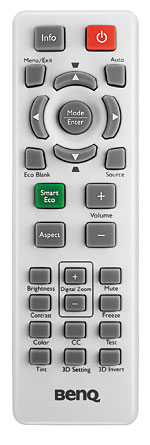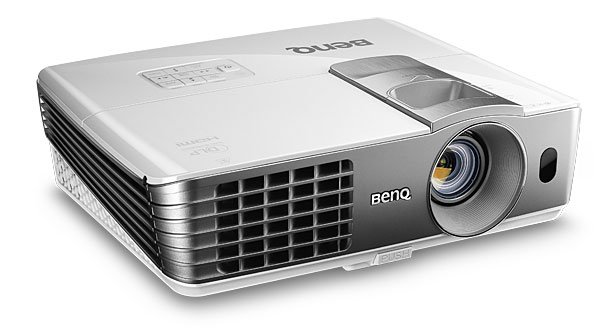BenQ W1070 3D DLP Projector Page 2
The only fly in the soup is the BenQ’s uninspiring black level. A full black screen shows as a middling shade of gray. This was bothersome on very dark scenes with low internal contrast, and to a lesser extent on dark scenes with bright highlights. Prometheus is an example of a movie that demands good black levels for its full impact. The film’s vitally important, dark cave scenes were poorly served here. But while many of today’s video displays, both flat screens and projectors, can produce far deeper blacks and more impressive contrast than the W1070, it’s only fair to point out that they’ll set you back hundreds (or, more likely, thousands) of dollars more.
 I was able to wring slightly better subjective dark scene performance out of the BenQ by switching on BrilliantColor, a feature developed by Texas Instruments (the daddy of DLP). While this is marketed as a color enhancement technology (color enhancement is almost always a dicey proposition if the display has been properly calibrated to begin with), its most visible impact here was to brighten the image rather significantly. That 22-ft-L peak white level increased to 28 ft-L without any measured increase in the black level. As you might expect, this really made the image pop. More importantly, however, it enhanced the bright details in otherwise dark scenes, slightly reducing the negative impact of the projector’s inherently poor blacks. It wasn’t a panacea and sometimes made light scenes uncomfortably bright (this could be moderated by increasing the gamma to 2.5), but it was a worthwhile option on some source material. The projector had been calibrated with BrilliantColor off; switching it on, in 2D, didn’t appear to produce any significant color shift apart from slightly rosier fleshtones. (I don’t recommend this BrilliantColor fix for 3D, however, where it produced a clearly visible color shift.)
I was able to wring slightly better subjective dark scene performance out of the BenQ by switching on BrilliantColor, a feature developed by Texas Instruments (the daddy of DLP). While this is marketed as a color enhancement technology (color enhancement is almost always a dicey proposition if the display has been properly calibrated to begin with), its most visible impact here was to brighten the image rather significantly. That 22-ft-L peak white level increased to 28 ft-L without any measured increase in the black level. As you might expect, this really made the image pop. More importantly, however, it enhanced the bright details in otherwise dark scenes, slightly reducing the negative impact of the projector’s inherently poor blacks. It wasn’t a panacea and sometimes made light scenes uncomfortably bright (this could be moderated by increasing the gamma to 2.5), but it was a worthwhile option on some source material. The projector had been calibrated with BrilliantColor off; switching it on, in 2D, didn’t appear to produce any significant color shift apart from slightly rosier fleshtones. (I don’t recommend this BrilliantColor fix for 3D, however, where it produced a clearly visible color shift.)
The rainbow effect (color fringing) also raised its head on the BenQ. This artifact is a product of the rotating color wheel required in any single-chip DLP projector and produces occasional brief flashes of rainbow-like color. This is visible here, as it typically is, mostly on bright highlights in otherwise dark scenes. Normally, I find it distracting, but not all viewers are bothered by it—and some can’t see DLP rainbows at all. I’d prefer never to see them, but the projector’s attractive price definitely made them easier to live with this time.
Three-D
The BenQ’s clipping of above video white and below video black information had little adverse effect on real 2D images. But when the projector is adjusted for adequate 3D brightness levels, the BenQ’s white clipping was more obvious. Early in Despicable Me, for example, you can see it in the windows behind Gru as he sits in his living room, and a little later as he begins the descent to his lair. You can also see it in the moon behind him as he reveals his latest nefarious plan to his minions. But such trouble spots were rare enough that I consider the clipping a defensible sacrifice for a watchably bright (though by no means standard-setting-bright) 3D image. I’m as much of a purist as the next video geek, but my first priority is enjoying the experience, and overly dim 3D just won’t hack it for me.
All things considered, the BenQ produced a satisfying 3D picture. The color and detail were more than respectable, and even the blacks were subjectively deeper than in 2D, likely thanks to the darker overall 3D image. And there was no obvious ghosting on the material I viewed, apart from the smallest hint of it on Avatar’s subtitles.

BenQ’s non-rechargeable 3D glasses are a little clunky and slow to lock on, but they work well. If you remove them while watching a dark scene, the gray background turns magenta. But don’t be alarmed by this; the glasses filter it back to a pure gray.
Conclusions
After measuring and watching the BenQ for weeks, I returned to my current reference projector, last year’s $3,500 JVC DLA-X30 (Home Theater, May 2012). The JVC’s far superior blacks not only improved dark scenes dramatically, but its deeper contrast and sharper resolution enlivened brighter scenes as well. The comparison is perhaps a little unfair, but in video as in many things in life, you usually get what you pay for.
Nevertheless, the BenQ had drawn me in. When a product isn’t quite making the grade, a reviewer typically rushes to check the usual boxes and get it over with. Not so here. On most material, I found myself glued to the chair, reluctant to get up and change to another disc even after the current one had served its purpose in the evaluation. In short, I could tune out the W1070’s limitations. Only when returning to a far more expensive projector was I reawakened to them.
A Top Pick, then? No, I can’t quite go there. But the BenQ W1070 scores plenty high on the value quotient. If you can deal with its price-driven shortcomings, it might just be your most affordable route to a true, big-screen home theater experience.
- Log in or register to post comments




































































